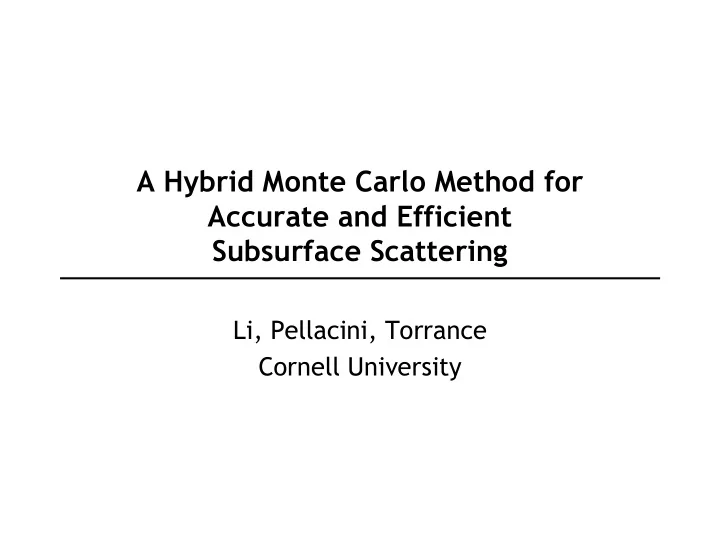

A Hybrid Monte Carlo Method for Accurate and Efficient Subsurface Scattering Li, Pellacini, Torrance Cornell University
Subsurface Scattering • Looks good without subsurface with subsurface [Jensen et al. ‘02]
Subsurface Scattering directional- diffuse behavior uniform- diffuse behavior
Optically thin/thick materials thick optical thickness = “size”/mfp thin translucent appearance transparent
Previous work • Accurate for all materials, but inefficient – Monte Carlo path/light tracing • Efficient, but inaccurate for most materials – First-order approximation [H & K93] – Diffusion approximation [Stam95] – Jensen at el. BSSRDF approximation [Jen01,Jen02] – Shell Texture Functions [Chen04]
Goal • Accurate and Efficient for all materials – As accurate as Monte Carlo – More efficient than Monte Carlo • Hybrid algorithm – Monte Carlo to capture directional-diffuse behavior – Dipole approx. to capture uniform-diffuse behavior
Hybrid method directional- diffuse isotropic behavior core region uniform- diffuse behavior mfp • Isotropic core region – 1 mfp below surface
Hybrid method directional- diffuse isotropic behavior core region uniform- diffuse behavior mfp • Monte Carlo path-trace until core region – Check for distance to surface using kd tree lookup
Hybrid method directional- diffuse isotropic behavior core region uniform- diffuse behavior mfp • Determine k ud constant to conserve energy – k < 1 in most cases, k = 0 in regions of high curvature
Hybrid method directional- diffuse isotropic behavior core region uniform- diffuse behavior mfp • Use dipole approx. for uniform-diffuse
Monte Carlo path tracing solution r r r r n i S ( x , ; x , ) S ( x , ; x , ) � � � = � � i i o o i i o o i
Jensen et al. BSSRDF approximation r r r r 1 S ( x , ; x , ) S ( x , ; x , ) � � � � � + i i o o i i o o r r S ( x , ; x , ) + � � d i i o o First-order approx. Dipole-diffusion approx.
Comprehensive BSSRDF model r r r r S ( x , ; x , ) S ( x , ; x , ) � � � � � + i i o o dd i i o o r r r r k ( x , ; x , ) S ( x , ; x , ) + � � � � � ud i i o o ud i i o o Isotropic core Directional-diffuse Uniform-diffuse
Comparison with pure Monte Carlo • Key insight: use dipole approx. when appropriate • Same Accuracy – Photons contributes to uniform diffuse behavior only when entering core region – Otherwise contributes to directional-diffuse, i.e. angular dependence is well represented • Efficiency – MC methods are inefficient when many scattering events are needed – Use dipole approx. in this case
Comparison with Jensen et al. • Jensen et al. approximations come from – One scattering event for directional-diffuse – Uniform-diffuse behavior always present, i.e. k = 1 • Inaccurate for optically-thin – Multiple scattering before entering core region – Often no uniform-diffuse behavior
Results – Armadillo Monte Carlo Hybrid Jensen et al. 246 min 33 min 10 min
Results – Thick Dragon Monte Carlo Hybrid Jensen et al. 1992 min 209 min 45 min
Results – Thin Dragon Monte Carlo Hybrid Jensen et al. 1328 min 191 min 46 min
Conclusion • Accurate and Efficient Subsurface Scattering – Extend accuracy to optically-thin materials – Maintain efficiency compared to full simulation – Explanation of artifacts introduced in other approx.
Future work • Increase efficiency further – Hierarchical estimation [Jensen et al. 2002] – Speed up distance-to-surface calculation • Extend to more materials – Inhomogeneous materials – Layered materials • Comprehensive model – Introduce more accurate refraction distribution
Recommend
More recommend